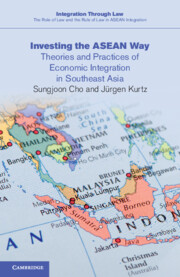Book contents
- Investing the ASEAN Way
- Integration Through Law
- Investing the ASEAN Way
- Copyright page
- Contents
- Figures
- Tables
- Preface
- General Editors’ Preface
- Acknowledgments
- Table of Cases
- Abbreviations
- Chapter 1 Introduction
- Chapter 2 The Foundation of the ASEAN Investment Regime
- Chapter 3 Tracing Influences on the ASEAN Investment Regime
- Chapter 4 Positioning of the ASEAN Investment Regime
- Chapter 5 Synthesis
- Chapter 6 Conclusion: Economic Regionalism and ASEAN Investment
- Bibliography
- Index
Chapter 3 - Tracing Influences on the ASEAN Investment Regime
Published online by Cambridge University Press: 10 November 2022
- Investing the ASEAN Way
- Integration Through Law
- Investing the ASEAN Way
- Copyright page
- Contents
- Figures
- Tables
- Preface
- General Editors’ Preface
- Acknowledgments
- Table of Cases
- Abbreviations
- Chapter 1 Introduction
- Chapter 2 The Foundation of the ASEAN Investment Regime
- Chapter 3 Tracing Influences on the ASEAN Investment Regime
- Chapter 4 Positioning of the ASEAN Investment Regime
- Chapter 5 Synthesis
- Chapter 6 Conclusion: Economic Regionalism and ASEAN Investment
- Bibliography
- Index
Summary
Chapter 3 discusses the subsequent stage of the evolution of the AIR. The ASEAN member states shift dramatically from the start-point of the 1987 ASEAN Investment Agreement. Chapter 3 shows that this start-point was marked by a remarkable degree of conservativism, with the member states unwilling to extend fundamental liberal and protective guarantees typically found in their BITs with third countries among themselves. By contrast, Chapter 3 traces a fundamental shift by the late 1990s, where a series of internal and external events would push those members to dramatically reshape their approach to investment rules. The combination of the disastrous effects of the 1997–1998 Asian financial crisis and the rise of China as a serious economic competitor would force those states to begin to develop a deeper level of integration. That identity crisis fundamentally shapes both the normative orientation and legal norms within the 1998 ASEAN Framework Agreement. Though limited when measured against conventional legalization indicators, any such critique ignores the vitality and creativity of the key choices made in this time of crisis.
- Type
- Chapter
- Information
- Investing the ASEAN WayTheories and Practices of Economic Integration in Southeast Asia, pp. 76 - 115Publisher: Cambridge University PressPrint publication year: 2022



